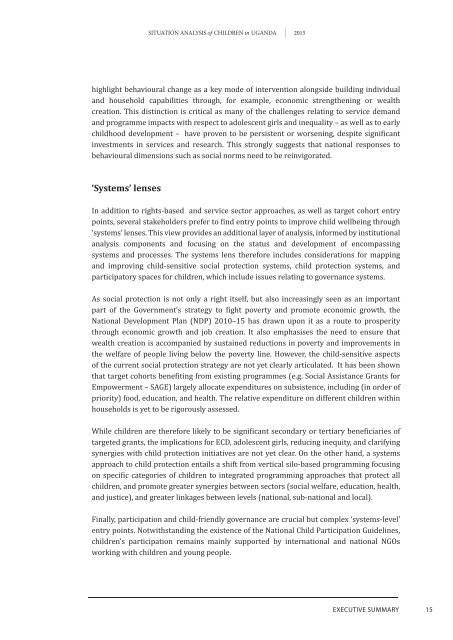Situation analySiS
1TNu802
1TNu802
Create successful ePaper yourself
Turn your PDF publications into a flip-book with our unique Google optimized e-Paper software.
<strong>Situation</strong> <strong>analySiS</strong> of Children in uganda 2015highlight behavioural change as a key mode of intervention alongside building individualand household capabilities through, for example, economic strengthening or wealthcreation. This distinction is critical as many of the challenges relating to service demandand programme impacts with respect to adolescent girls and inequality – as well as to earlychildhood development – have proven to be persistent or worsening, despite significantinvestments in services and research. This strongly suggests that national responses tobehavioural dimensions such as social norms need to be reinvigorated.‘Systems’ lensesIn addition to rights-based and service sector approaches, as well as target cohort entrypoints, several stakeholders prefer to find entry points to improve child wellbeing through‘systems’ lenses. This view provides an additional layer of analysis, informed by institutionalanalysis components and focusing on the status and development of encompassingsystems and processes. The systems lens therefore includes considerations for mappingand improving child-sensitive social protection systems, child protection systems, andparticipatory spaces for children, which include issues relating to governance systems.As social protection is not only a right itself, but also increasingly seen as an importantpart of the Government’s strategy to fight poverty and promote economic growth, theNational Development Plan (NDP) 2010–15 has drawn upon it as a route to prosperitythrough economic growth and job creation. It also emphasises the need to ensure thatwealth creation is accompanied by sustained reductions in poverty and improvements inthe welfare of people living below the poverty line. However, the child-sensitive aspectsof the current social protection strategy are not yet clearly articulated. It has been shownthat target cohorts benefiting from existing programmes (e.g. Social Assistance Grants forEmpowerment – SAGE) largely allocate expenditures on subsistence, including (in order ofpriority) food, education, and health. The relative expenditure on different children withinhouseholds is yet to be rigorously assessed.While children are therefore likely to be significant secondary or tertiary beneficiaries oftargeted grants, the implications for ECD, adolescent girls, reducing inequity, and clarifyingsynergies with child protection initiatives are not yet clear. On the other hand, a systemsapproach to child protection entails a shift from vertical silo-based programming focusingon specific categories of children to integrated programming approaches that protect allchildren, and promote greater synergies between sectors (social welfare, education, health,and justice), and greater linkages between levels (national, sub-national and local).Finally, participation and child-friendly governance are crucial but complex ‘systems-level’entry points. Notwithstanding the existence of the National Child Participation Guidelines,children’s participation remains mainly supported by international and national NGOsworking with children and young people.ExECUtIvE SUMMary15




